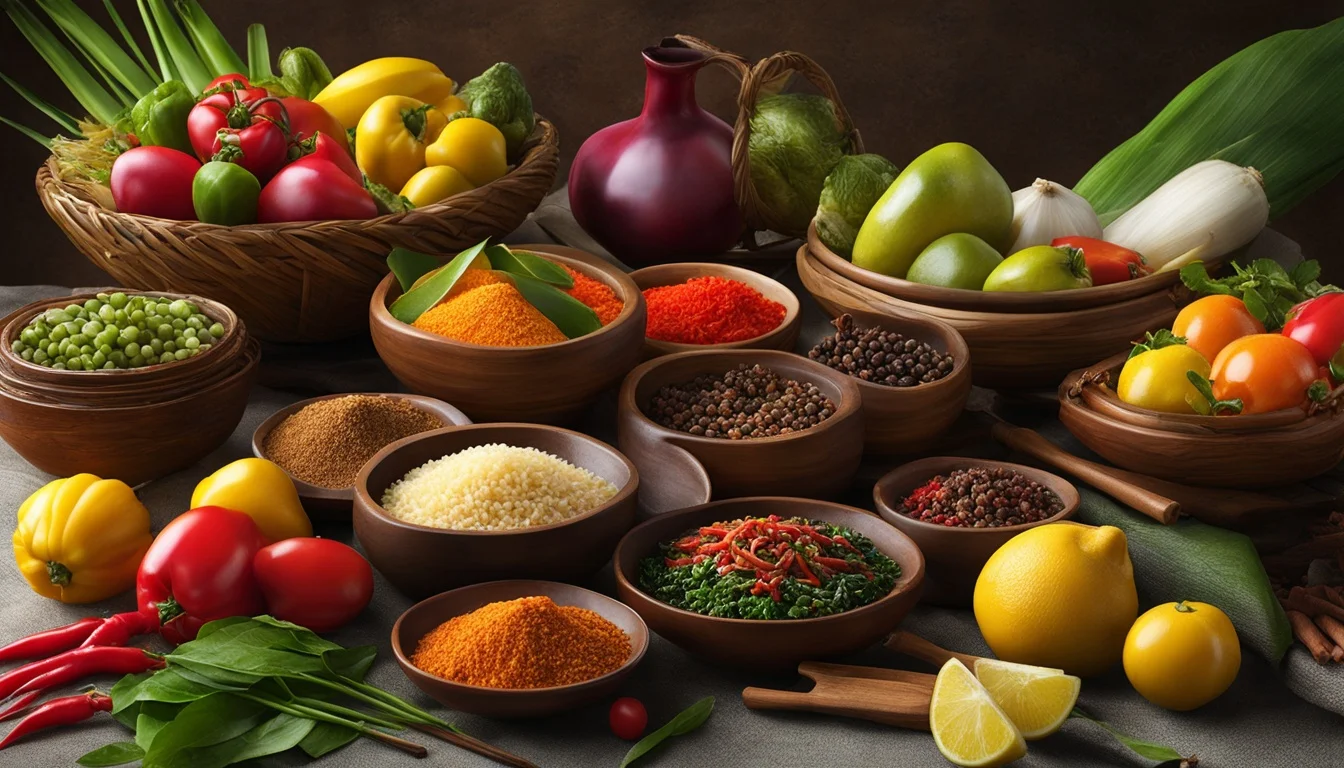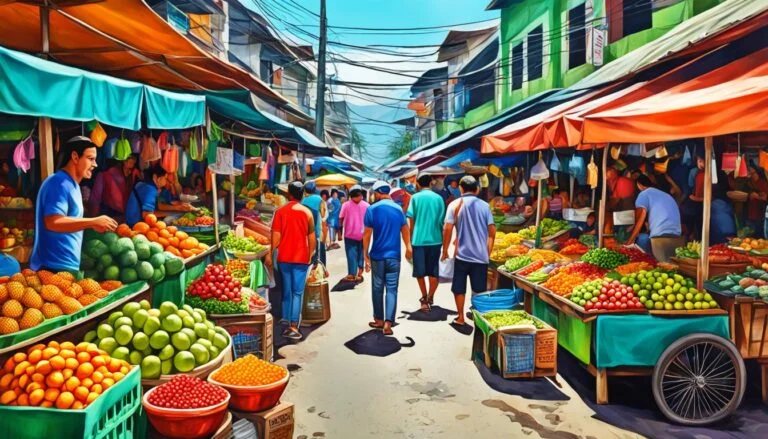A Foodie’s Guide to the Best Local Cuisine in the Philippines!
Have you ever wondered what makes Filipino cuisine so unique and captivating? From the tropical islands of the Philippines comes a vibrant, diverse, and flavorful culinary landscape that is often overlooked on the global stage1. Filipino cuisine typically involves 5-7 meals a day, including early breakfast, breakfast, morning snack, lunch, afternoon snack, dinner, and pulutan (small bites while drinking)1. Sourness is a prevalent flavor in native Filipino food, sourced mainly from fruits, leaves, and fermentation1. The Philippines offers a wide variety of vinegars, including coconut sap, pineapple, sugar cane, palm, and banana1. Filipino cuisine emphasizes the use of rice as a staple, often enjoyed with dishes like adobo, sinigang, and kare-kare.
Key Takeaways
- Discover the diverse and vibrant flavors of Filipino cuisine, including its unique use of vinegars and sour notes.
- Explore the importance of rice and dipping sauces in traditional Filipino dining experiences.
- Uncover the influence of neighboring Asian cuisines and Spanish colonial history on the development of Filipino food culture.
- Gain insights into the traditional dining practices and unique condiments that define the Filipino culinary identity.
- Understand the significance of food and hospitality in Filipino society, reflected in everyday greetings and customs.
The Origins and Influences of Filipino Cuisine
Filipino cuisine is often referred to as one of the world’s earliest fusion cuisines, blending indigenous ingredients with influences from Chinese, Spanish, American, Japanese, and other global culinary traditions2. This diverse heritage has resulted in a regional and local cuisine that is highly varied, with hundreds if not thousands of unique dishes across the Philippines’ many islands2. Understanding the origins and key influences that have shaped Filipino food culture is essential to appreciating the depth and complexity of this dynamic cuisine.
At its core, Filipino cuisine is a diverse representation of over a hundred distinct ethnolinguistic groups found across the country’s 7,641 islands34. The most prominent Filipino cuisines come from regions like Tagalog, Pangalatok (from Pangasinan), Visayan (Cebuano, Hiligaynon, and Waray), Ilocano, Kapampangan (from Pampanga), Bicolano, Chavacano, and Maranao provinces2. This regional diversity is reflected in the wide array of local dishes, each with its own unique flavor profile and preparation methods.
Filipino cuisine has been shaped by a rich tapestry of global influences, from the Austronesian heritage shared with maritime Southeast Asia to the culinary traditions of China, Spain, and the United States34. The Spanish colonization of the Philippines for 300 years introduced dishes like *embutido*, *arroz valenciana*, *afritada*, and *menudo*, while Chinese merchants brought iconic Filipino noodle dishes like *pancit*4. The Manila galleon trade network also played a significant role in shaping Filipino cuisine, facilitating the exchange of ingredients and cooking techniques between the Philippines, Mexico, and beyond3.
Despite the many global influences, Filipino cuisine remains grounded in its indigenous roots, with the use of local ingredients like *kalamansi*, *pili nut*, and *tabon-tabon fruit* in popular dishes like *adobo* and *tinapa*3. The combination of sweet, sour, salty, and sometimes spicy flavors is a hallmark of this vibrant culinary tradition, reflecting the dynamic interplay of the Philippines’ diverse cultural heritage324.
Key Characteristics of Traditional Filipino Dishes

Filipino cuisine is a tapestry of diverse regional flavors, united by distinct cooking techniques, signature ingredients, and unique eating customs5. The Philippines’ archipelagic nature, with over 7,000 islands, has given rise to a culinary landscape that is both diverse and unified5. At the heart of traditional Filipino dishes are three primary flavor profiles: salty, sour, and sweet, with a subtle emphasis on bitter tastes5.
Central to Filipino cuisine is the art of *adobo*, a cooking method that involves stewing in a pungent blend of vinegar, soy sauce, and spices6. This process not only imparts a signature flavor but also served as a historical means of food preservation6. Additionally, the use of *bagoong* (fermented shrimp paste) and a vast array of vinegar varieties, including cane, coconut, and even pineapple, lend unique sour notes to many classic dishes5.
Pork is a beloved ingredient in Filipino cooking, featured in dishes such as *lechon* (roast suckling pig), *longganisa* (Filipino sausage), and *tocino* (cured meat)5. However, the resourcefulness of Filipino chefs extends beyond pork, as they often utilize various parts of animals to create flavorful and economical meals7. Rice, a staple in the Filipino diet, is present in every meal, whether it’s served steamed, fried, or incorporated into desserts5.
Dining in the Philippines is a social experience, often enjoyed in the *kamayan* style, where food is eaten with the hands and shared among family and friends5. No meal is complete without the *sawsawan*, a selection of dipping sauces that add an extra layer of flavor and texture to the dish5. This unique dining culture, combined with the diverse ingredients and cooking techniques, makes traditional Filipino cuisine a true delight for the senses567.
Must-Try Iconic Filipino Foods
Filipino cuisine offers a wealth of iconic dishes that have gained global recognition. From the savory *adobo* and the tangy *sinigang* to the celebratory *lechon* and the beloved street food *sisig*, these quintessential Filipino foods showcase the diversity, creativity, and bold flavors that define the country’s culinary landscape8.
Other must-try Filipino favorites include the noodle dish *pancit* and the refreshing *halo-halo* dessert. The rich, peanut-based *kare-kare* stew also stands out as a beloved Filipino creation8.
The origins of these iconic dishes can be traced back to the Philippines’ diverse cultural influences. *Adobo*, for instance, is a classic Filipino dish that is influenced by Spanish cooking processes and ingredients native to Southeast Asia9. *Lechon*, the popular roasted whole pig, is cooked with varying seasonings and dips, reflecting the country’s culinary traditions9.
Similarly, the beloved *sinigang* is considered by many as the unofficial national dish of the Philippines, characterized by its sour and savory flavors9. *Pancit*, the traditional Filipino noodle dishes, were introduced by Chinese immigrants and have since adopted Spanish influences9.
From the spicy *Bicol Express* to the grilled *Inihaw Na Liempo*, Filipino cuisine offers a diverse array of flavors and culinary traditions that are sure to delight the senses. Whether it’s the comforting *silog* dishes or the iconic *halo-halo* dessert, these must-try Filipino foods are a testament to the country’s rich culinary heritage10.
Philippines local cuisine: Regional Specialties

The Philippines’ diverse geography, spanning the islands of Luzon, Visayas, and Mindanao, has given rise to a rich and varied culinary landscape11. Each region boasts its own unique set of local ingredients, cooking methods, and signature dishes that have been shaped by the country’s history, culture, and traditions11.
In Luzon, the Pampanga region is renowned as the “Culinary Capital of the Philippines,” offering a tantalizing array of savory dishes12. One standout is Sisig, a sizzling appetizer made of diced pork, chicken liver, and chili peppers, which originated over 40 years ago with Lucia Cunanan’s culinary innovation12. Another must-try is Bagnet, a pork belly dish deep-fried to crispy perfection, with the Herencia Cafe in Paoay, Ilocos Norte being a notable establishment for this delicacy12.
Traveling south to the Bicol Region, visitors will be captivated by the spicy coconut-based dishes that have become synonymous with the area12. Laing, a dish made of sun-dried taro leaves cooked in coconut milk and chili peppers, is a regional specialty that can be savored at the renowned Bob Marlin restaurant in Naga City12.
Across the Visayas, the region is renowned for its mouthwatering lechon (roast pork) and batchoy, a noodle soup made with pork, beef, and offal13. Meanwhile, Mindanao in the southern Philippines boasts its own unique culinary gems, including the grilled and barbecued specialties that have become a beloved part of the local food culture11.
Exploring these regional culinary treasures is an essential part of any foodie’s adventure in the Philippines, offering a tantalizing glimpse into the diverse flavors and traditions that have shaped the nation’s vibrant cuisine111213.
The Filipino Culinary Experience

Filipino cuisine is a vibrant tapestry, woven with influences from indigenous, Spanish, Chinese, and American culinary traditions14. The Philippines boasts a blend of these diverse flavors, resulting in iconic dishes like adobo and lechon that are renowned worldwide for their unique tastes14. The street food scene in the Philippines also offers adventurous eaters popular options such as balut and isaw14, while Filipino desserts like leche flan and halo-halo showcase the country’s sweet tooth culture14.
Eating is deeply ingrained in Filipino culture, with meals often serving as social gatherings and celebrations. Filipinos typically greet each other with “Kumain ka na ba?” (Have you eaten?), and hosting guests often involves abundant servings of food15. Traditional dining customs, such as eating with the hands in the kamayan style, and the ubiquity of dipping sauces known as sawsawan, further enhance the unique cultural experience of enjoying Filipino cuisine14.
Local markets in Bohol, Cebu, Dumaguete, and Iloilo provide opportunities to engage with fresh produce and interact with vendors14, while cooking classes and food tours in the Philippines enable participants to learn the art of preparing iconic dishes like adobo and sinigang14. Popular Filipino beverages, such as buko juice, calamansi juice, and the iconic San Miguel beer, are perfect for pairing with the local cuisine14.
Efforts towards sustainable dining practices are also evident in various regions of the Philippines, focusing on farm-to-table concepts and reducing single-use plastics14. Additionally, restaurants in the Philippines offer stunning views, with seaside and mountaintop dining options showcasing the country’s natural beauty14.
The Filipino culinary experience is a rich tapestry of flavors, traditions, and hospitality, inviting visitors to immerse themselves in the unique and vibrant Filipino food culture16. From the bustling streets to the tranquil countryside, the dining customs and social gatherings around food are an integral part of the Filipino way of life151416.
Best Local Markets and Food Tours

Exploring the vibrant *local markets* and joining guided *culinary tours* are excellent ways to fully immerse yourself in the diverse *food tourism* of the Philippines. From the bustling *local markets* of *Metro Manila* to the specialty food stalls and vendors found throughout the islands, these experiences offer a behind-the-scenes look at the ingredients, preparation methods, and traditions that define Filipino cuisine17.
In Pampanga, recognized as one of the *food capitals* of the Philippines, visitors can dine at renowned establishments like Atching Lillian, which requires reservations weeks in advance to savor its preserved traditional Kapampangan cuisine17. The region also boasts Taldawa, a restaurant specializing in goat and duck dishes, and 25 Seeds, a restaurant by Chef Sau Del Rosario that emphasizes the use of high-quality Filipino ingredients17.
Manila’s *culinary tours* and *local markets* provide a window into the diverse food culture of the Philippines. Makansutra Hawkers, situated at SM Megamall, offers a variety of dishes from Singapore and Malaysia within a hawker food court setting17. Zubuchon Lechon, acclaimed for its exceptional lechon, famously praised by Anthony Bourdain, also has a branch in Manila maintaining the same renowned recipe17.
Venturing beyond the capital, the *local markets* in Cebu City offer authentic experiences amidst the noise, crowds, and smelly corners, providing a glimpse into the daily life of Filipinos18. Colon Street, the oldest street in the Philippines, showcases a mix of historical significance and present-day commerce, while Taboan Market is a haven for danggit, a dried fish delicacy, and Chorizo of Cebu, a popular choice for street barbeques18.
These *culinary tours* and *local markets* in the Philippines are essential for any *food tourism* enthusiast, offering a unique opportunity to immerse themselves in the country’s rich and diverse culinary heritage19.
Recreating Filipino Flavors at Home
For those unable to travel to the Philippines, bringing the flavors of Filipino cuisine into your own kitchen is a rewarding way to explore this vibrant culinary tradition. Filipino recipes can be recreated with a little research and experimentation, allowing home cooks to unlock the bold, versatile, and often unexpected tastes that make this cuisine so unique and delicious20.
Key ingredients like vinegar, bagoong (fermented shrimp paste), and calamansi (Philippine lime) can be sourced from specialty Asian markets or online, while traditional techniques like adobo and sinigang can be mastered at home20.
The popularity of Filipino home cooking has grown globally, with chefs and bloggers sharing innovative ways to reinvent classic dishes. From ube butter jars to Filipino-inspired chocolate chip cookies, the vibrant flavors of the Philippines are finding new audiences around the world21.
At the heart of this culinary exploration is the beloved dish of adobo, considered the national dish of the Philippines22. Adobo’s versatility allows for endless variations, with families passing down their unique recipes across generations22. Whether it’s pork belly, chicken, or a combination, the key is mastering the balance of soy sauce, vinegar, and spices that define this iconic Filipino recipe22.
By embracing the rich history and diverse flavors of Filipino cuisine, home cooks can transport themselves to the vibrant markets and bustling streets of the Philippines, one delicious bite at a time202122.
Conclusion
Filipino cuisine is a dynamic and diverse culinary tradition that deserves greater recognition on the global stage23. From its centuries-old fusion of indigenous and global influences to its distinctive flavors and eating customs, the local cuisine of the Philippines offers a truly unique and unforgettable food experience24. Whether you’re planning a trip to the Philippines or exploring Filipino restaurants in your own backyard, this guide has provided a comprehensive introduction to the rich, complex, and utterly delicious world of Filipino food culture25.
The Filipino cuisine showcases a diverse range of flavors due to the country’s history of colonization23, with quality ingredients, especially fresh fish and seafood, contributing to the excellent taste of the dishes23. Many Filipino dishes are suitable for various diet plans due to their healthy qualities23, and home-cooked Filipino meals are highly valued for their freshness and loving preparation23. Furthermore, Filipino food is known to be affordable, making it accessible to a wider audience23. Cooking is a passion for many Filipinos, resulting in delicious and varied cuisine choices in the Philippines23.
As the culinary adventure continues, Filipino cuisine is gaining recognition globally, with more Filipino restaurants being established in various countries25. The culinary landscape is evolving, with Filipino cuisine being acknowledged for its complex and diverse flavors influenced by various cultures25. From the vibrant celebrations of the National Filipino Food Month to the delectable dishes showcased by renowned chefs and authors, the world is discovering the unique and captivating essence of Filipino food24.







